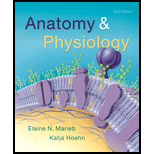
The structures that draw an ovulated oocyte into the female duct system are (a) cilia, (b) fimbriae, (c) microvilli, (d) stereocilia.
Introduction:
The process of ovulation is defined as the release of eggs from the overies. This event occurs in humans, when the ovarian follicles rupture and release the secondary oocyte ovarian cells. During the process of ovulation, fimbriae get activated and hit the ovary in a gentle and sweeping motion. The release of oocyte from ovary is takes place in peritoneal cavity and cilia of the fimbriae draw the ovum into the fallopian duct.
Answer to Problem 1MC
Correct answer:
The structures that draw an ovulated oocyte into the female duct system are Cilia
Fimbriae.
Explanation of Solution
Explanation for the correct answer:
The fimbriae are finger-like projections present at the end of the fallopian tube. During ovulation, the sex hormones accelerate the fimbriae and result in the inflammation. This causes a motion and allows the oocyte to release from the ovary. Cilia are present on the fimbriae and help in capturing oocyte into the uterine tube and finally toward uterus.
Explanation for the incorrect answers:
Option (c) states that microvilli are the structures that draw an ovulated oocyte into the female duct system. Microvilli are the cellular membrane protrusions that are present on the surface of the cells and their main function is the cellular adhesion. Hence this is an incorrect option.
Option (d) states that stereocilia are the structures that draw an ovulated oocyte into the female duct system. The stereocilia are present on the hair cells that shows the response to fluid motion in different types of animals for various functions, including hearing and balance. Hence this is an incorrect option.
Thus it is concluded that fimbriae are the finger-like projections present at the end of the fallopian tube and during ovulation, the sex hormones accelerate the cilia of fimbriae that causes a motion and allows the oocyte to draw into the fallopian tube.
Want to see more full solutions like this?
Chapter 26 Solutions
Anatomy & Physiology (6th Edition)
- please fill in the empty sports, thank you!arrow_forwardIn one paragraph show how atoms and they're structure are related to the structure of dna and proteins. Talk about what atoms are. what they're made of, why chemical bonding is important to DNA?arrow_forwardWhat are the structure and properties of atoms and chemical bonds (especially how they relate to DNA and proteins).arrow_forward
- The Sentinel Cell: Nature’s Answer to Cancer?arrow_forwardMolecular Biology Question You are working to characterize a novel protein in mice. Analysis shows that high levels of the primary transcript that codes for this protein are found in tissue from the brain, muscle, liver, and pancreas. However, an antibody that recognizes the C-terminal portion of the protein indicates that the protein is present in brain, muscle, and liver, but not in the pancreas. What is the most likely explanation for this result?arrow_forwardMolecular Biology Explain/discuss how “slow stop” and “quick/fast stop” mutants wereused to identify different protein involved in DNA replication in E. coli.arrow_forward
- Molecular Biology Question A gene that codes for a protein was removed from a eukaryotic cell and inserted into a prokaryotic cell. Although the gene was successfully transcribed and translated, it produced a different protein than it produced in the eukaryotic cell. What is the most likely explanation?arrow_forwardMolecular Biology LIST three characteristics of origins of replicationarrow_forwardMolecular Biology Question Please help. Thank you For E coli DNA polymerase III, give the structure and function of the b-clamp sub-complex. Describe how the structure of this sub-complex is important for it’s function.arrow_forward
 Human Physiology: From Cells to Systems (MindTap ...BiologyISBN:9781285866932Author:Lauralee SherwoodPublisher:Cengage Learning
Human Physiology: From Cells to Systems (MindTap ...BiologyISBN:9781285866932Author:Lauralee SherwoodPublisher:Cengage Learning Human Biology (MindTap Course List)BiologyISBN:9781305112100Author:Cecie Starr, Beverly McMillanPublisher:Cengage Learning
Human Biology (MindTap Course List)BiologyISBN:9781305112100Author:Cecie Starr, Beverly McMillanPublisher:Cengage Learning Anatomy & PhysiologyBiologyISBN:9781938168130Author:Kelly A. Young, James A. Wise, Peter DeSaix, Dean H. Kruse, Brandon Poe, Eddie Johnson, Jody E. Johnson, Oksana Korol, J. Gordon Betts, Mark WomblePublisher:OpenStax College
Anatomy & PhysiologyBiologyISBN:9781938168130Author:Kelly A. Young, James A. Wise, Peter DeSaix, Dean H. Kruse, Brandon Poe, Eddie Johnson, Jody E. Johnson, Oksana Korol, J. Gordon Betts, Mark WomblePublisher:OpenStax College Concepts of BiologyBiologyISBN:9781938168116Author:Samantha Fowler, Rebecca Roush, James WisePublisher:OpenStax College
Concepts of BiologyBiologyISBN:9781938168116Author:Samantha Fowler, Rebecca Roush, James WisePublisher:OpenStax College Fundamentals of Sectional Anatomy: An Imaging App...BiologyISBN:9781133960867Author:Denise L. LazoPublisher:Cengage Learning
Fundamentals of Sectional Anatomy: An Imaging App...BiologyISBN:9781133960867Author:Denise L. LazoPublisher:Cengage Learning





